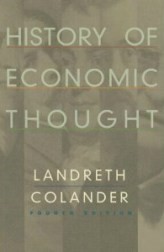PRINCIPLES OF ECONOMICS

by David Colander
9th edition
About my Principles book
My book presents the same material as the competitors, but it does so in a critical thinking approach, which means that you want students not only to learn the material, but to learn its limitations as well.
My goal is to present students with the best economics I can. That means that I want to teach modern economics, not neoclassical economics (or whatever else the collection of models that developed in the 1950s is called). That doesn’t mean that I don’t teach the traditional models; it just means that I integrate modern interpretations and insights with them. That approach makes the tone and format somewhat different from the 1950s tone and format of many competitors that make it seem as if economics hasn’t changed in 60 years.
Why haven’t competitors changed? Because it is really, really hard to deviate from the standard template developed in the 1950s. I fully recognize the difficulty. (After all I’m the one who coined the “15 percent rule” for textbooks.) I know and accept that if we are going to teach modern economics, it has to involve an evolutionary, not revolutionary, template. But recognizing the importance of the existing template is not a call for laziness and complacency in what we teach; it is a call for creativity. Economics has changed from what it was, and that means the content of the texts has to change as well. Texts that don’t embrace that change are becoming more and more out of date.
I write in a colloquial style that talks to students, not lectures to them. That colloquial style helps get student’s attention. It makes them feel that they are getting an additional tutor to back up the professor. This secondary tutor, while a bit of a pain in the ass at times, is at least human. That colloquial style helps with one of the biggest problems in the course—getting students involved with the material.
I get lots of e-mails from students—some ask me if I have sons who share my perverse sense of humor because they’d like to marry them; others tell me that I goofed somewhere. Others complain about their professor—to which I answer the professor is always right. My point is not the content of the e-mails; my point is that students feel comfortable emailing and even phoning me. Students hear my voice when reading the material.
Numerous students tell me that they actually break a smile when they read the narrative, and a few tell me they crack up. Just about everyone tells me that they recognize that the person writing is very human—all too human in some people’s view.
My colloquial style allows me greater flexibility in the material I present to students than most authors have. Because I’m having a conversation with the students, I can explain to them what material is new and is to be read casually rather than to be memorized. Then, elsewhere, where I am presenting material that will likely be on their exam, I can tell them that it is time to buckle down and memorize.
I see this blog as a way of reaching to students—to let them see my views about policy and to keep them current on how I see economics affecting the ongoing policy debates.
___________________________________________________________________
HISTORY OF ECONOMIC THOUGHT

Harry Landreth (Author), David C. Colander (Author)
An upper-level text, History of Economic Thought continues to offer a lively, accessible discussion of ideas that have shaped modern economics. The Fourth Edition has been thoroughly revised to reflect recent scholarship and research, as well as a more pointed focus on modern economic thought. The text remains a highly understandable and opinionated–but fair–presentation of the history of economic thought. This book can be accessed using the links below. Click on chapter titles to read by chapter, or click on the title of the book to see the entire book.
History of Economic Thought by Harry Landreth (Author), David C. Colander (Author) (pdf)
Chapter 2: Early Preclassical Economic Thought
Chapter 3 Mercantilism, Physiocracy, and Other Precursors of Classical Economic Thought
Chapter 5: Ricardo and Malthus Chapter 6: J.S. Mill and the Decline of Classical Economics Chapter 7: Karl Marx and His Critique of Classical Economics
Chapter 8: Jevons Mender and the Foundations of Marginal Analysis
Chapter 9: The Transition to Neoclassical Economics: Marginal Analysis Extended
Chapter 10: Alfred Marshall and Neoclassical Economics
Chapter 11: Walras and General Equilibrium Theory
Chapter 12: Institutional and Historical Critics of Neoclassical Economics
Chapter 14: The Development of Modern Microeconomic Theory
Chapter 15: The Development of Modern Macroeconomics Thought
Chapter 16: The Development of Econometrics and Empirical Methods of Economics
Chapter 17: The Development of Modern Heterodox Economic Thought